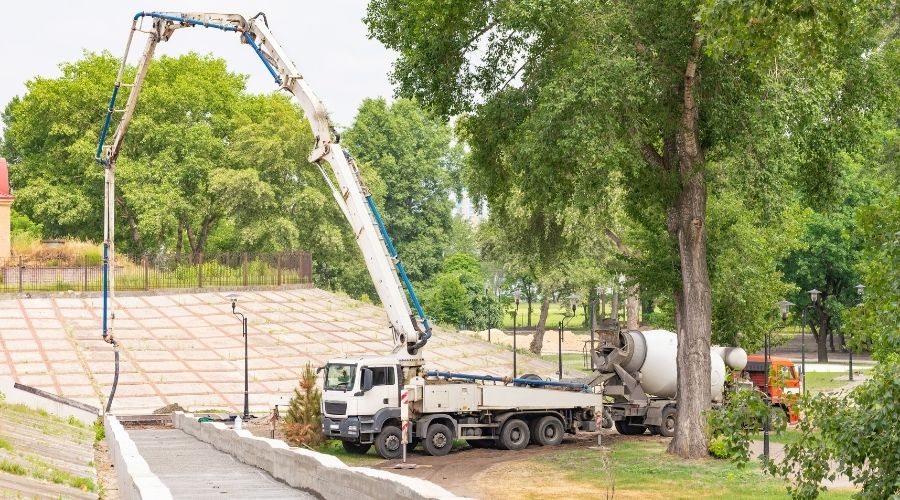
Since the early 1990s, other industries (such as the manufacturing industry) have doubled productivity levels. When it comes to the construction industry, however, productivity growth has remained flatlined for decades.
To increase productivity and lower costs, the construction industry must look to new and innovative technologies. This includes concrete pumping.
Let’s break down concrete pumping and how it can benefit the construction industry as a whole.
What is concrete pumping?
Concrete pumping is a method used to place concrete in a specific location. During this process, a mixing truck transfers liquid concrete from a hopper to a concrete pump. The liquid churns continuously to avoid premature solidification.
How does a concrete pump work?
A concrete pump functions by taking advantage of differentials between atmospheric and hydraulically-induced pressures. The concrete is placed into the hopper, and the pump kit uses hydraulic cylinders to collect and discharge concrete throughout the system via a rock valve.
What does a concrete pump look like?
A concrete pump traditionally looks like a long slender boom. During the concrete pumping process, there will be a group of people on the placement end and a line of redi-mix trucks on the other.
When is concrete pumping used?
Concrete pumping is used to facilitate a safer, more efficient method of placing concrete. This is common in locations where conditions limit mobility of labor, equipment, and materials.
Here are some common examples of when concrete pumps are used:
-
- Bridge Deck Placement: Longer bridge decks and the sheer volume of placement required can only be executed via a concrete pump or a conveyor.
- Slab on Deck (Elevated): Utilizing slick line and mini placers is far more efficient than utilizing buckets or buggies. The rate of placement and redirected labor efficiency increase placement and crew productivity.
- High Rise Buildings: Multi-story high rises and tall vertical walls require the use of alternate placing methods. Cranes slinging buckets can’t be utilized for anything else during placement, and placement rates decrease with increases in height.
- Parking Structures: Due to the design of a typical multi-level parking garage, concrete placement can become a major challenge. A concrete pump can help distribute concrete to all levels quickly, with little to no waste in the process.
What are the benefits of concrete pumping?
There are a variety of concrete pumping benefits. Let’s take a look at some of the most common reasons construction sites tend to work with a concrete pump.
- Increased Productivity: Utilize labor more efficiently by increasing placement rate.
- Reduced Construction Live Loads: Eliminate rutting from truck dumping in slab on grade placements, buggy loads on slab on deck placements.
- Supplier Efficiency: Turn more loads in less time when compared to truck dumping.
- Safety: Residential basement walls see unintended surcharge when redi-mix trucks are placed too close to open excavations.
- Erosion Control/Environmental Protection: Concrete from discharge is localized, mud and dirt from travel is minimized.
What are the different types of concrete pumps?
The two types of concrete pumps vary by placement only.
Line pumps utilize pieces of pipes joined together in conjunction with hoses to facilitate placement. Boom pumps, on the other hand, provide connected boom sections to hold piping for instantaneous reach without setting up a line system.
Keep in mind, the combination of boom pumps and line systems are often advantageous and can optimize concrete placement.
What is a concrete line pump?
Line pumps are specifically helpful in situations where boom pumps either cannot go far enough or high enough. They are also extremely beneficial when used in remodeling – like winding through hallways, downstairs, or through small basement windows.
What is a concrete boom pump?
A boom pump is utilized to rapidly increase placement within up to 200-foot radius of the boom pump location. These pumps are ideal for mass footings, bridge decks, vertical walls, large slabs, and other mass placements where rapid turn around on large volumes is required.
Want to learn more about concrete pumping?
We’d love to talk! At Intelligent Concrete, we have decades of combined experience working with advanced concrete technologies, including concrete pumping. If you have unanswered questions, reach out to us online or check out our related material below!
Related Content:
- Elon Musk and the future of concrete innovation
- Creating the perfect high range water reducer
- What is soft water attack on concrete?
- What is concrete IoT?

I like that you talked about how concrete pumping is a method used to place concrete in a specific location. We are building a new house and we definitely need a supply of concrete for the project. In order to make things much easier, we should probably ask for a residential concrete pumping service.
https://www.citygroup.net.au/
That sounds like a good direction.
Thanks for pointing out that concrete pumping can also be good for paving parking spaces. I’d like to find a good concrete pumping service soon because I plan to work on getting a new business opened soon. Preparing the establishment would be very important because that will surely leave an impression on the customers.
https://www.hanoverconcrete.com/concrete-pump-rental
Good idea.